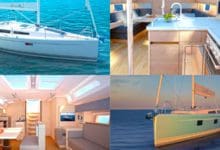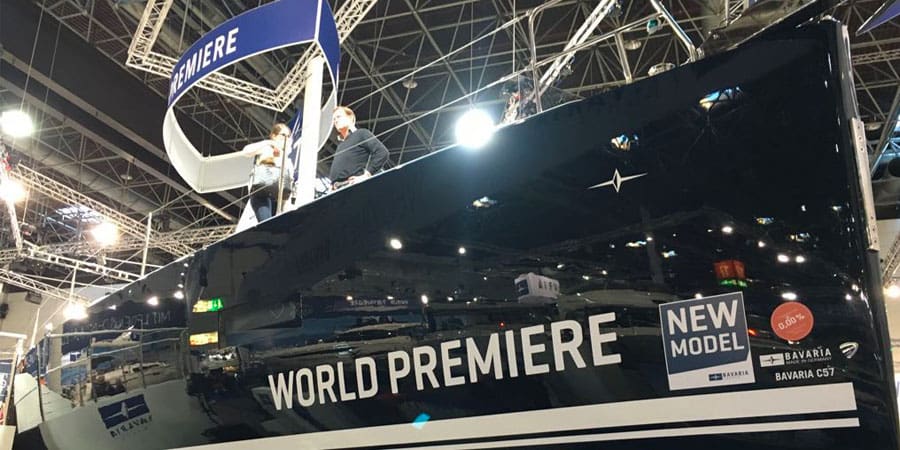The current yacht designs meet a great variety of needs of yachtsmen. The new models on display at BOOT Dusseldorf 2018 from January 20th to 28th show that they are suitable both for cruising and performance sailing.
Extensive space on board allows the yachts to be sailed with large crews, and yet the short-hand principle is often sufficient for operating the boat safely in cruising conditions. Halyards, stretchers and sheets are all brought together centrally in the cockpit on most yachts, so that leaving the helm is rarely necessary during manoeuvres.
In addition to clearly structured workspaces, modern yachts usually also offer large areas for recreation and socializing on board – both on and below deck. In addition, a lot of natural light in the cabins makes life onboard a pleasure.
Development of design details of the latest-generation yachts continues very much along the lines of recent years. Straight bows and wide sterns ensure not only high-performance levels of the boats due to long water lines as well as great hydrostatical stability, but also greater space below decks for cabins and storage. What you will also see on many boats are powerful rigs with plenty of sail area.
And below the waterline, the appendages also follow the rules set by the performance goals of the boats. A low centre of gravity produces a high righting momentum, which in turn ensures upright sailing. Twin rudders make manoeuvring easy. These features of the current design standards range from superyachts down to handy-sized daysailers.
New Yachtdesigns 10 to 13 meters
This strict separation cannot be maintained to the same degree in smaller yachts between ten and 13 meters, of course. And yet, the designers have also put dual-steering wheels far aft on the Grand Soleil GS34 Performance, Hallberg-Rassy 340, Hanse 348, Najad 395 AC and Wauquiez Pilot Saloon 42 to allow for as much living space as possible in the cockpit.
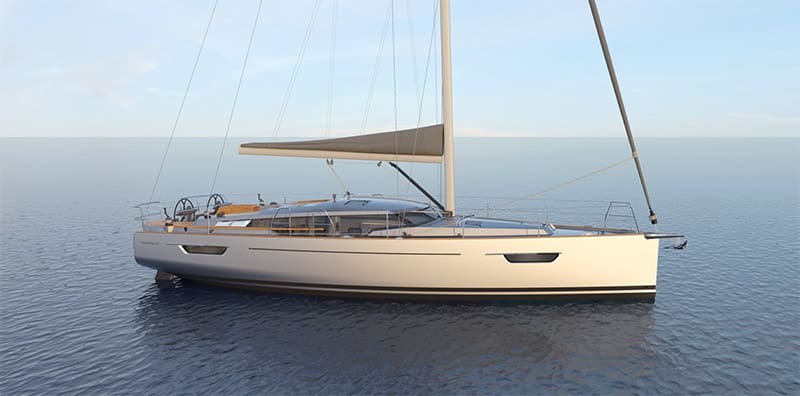
However, design differences between the yachts are bigger in the smaller class because less available space requires for more individualized solutions. The Swedes of Hallberg Rassy and Najad put more emphasis on traditional lines and thus on rather rounded shapes. They offer slightly tapered stern sections, while the other yards, as with the large yachts, prefer the wedge-shaped hulls with wide sterns.
New Yachts in the 50 ft Range
The new yachts in the range around 50ft come along a lot like smaller sisters of the superyachts. The Bénéteau Oceanis 51.1, Hanse 548, Sun Odyssey 490 or X49 seem a bit more compact due to their shorter length and the cabin superstructures a little more voluminous in relation to the hull, but the purist lines are still clearly there. And the 50-footers also allow a lot of natural light into the interior thanks to the long row of windows.

However, there are boats like, for example, the Amel 50 with its covered cockpit area who make a clear design statement of their own. Although the protective shield against sea and weather conditions rises up high, the windows reach all the way round and allow a good 360° view of the surroundings.
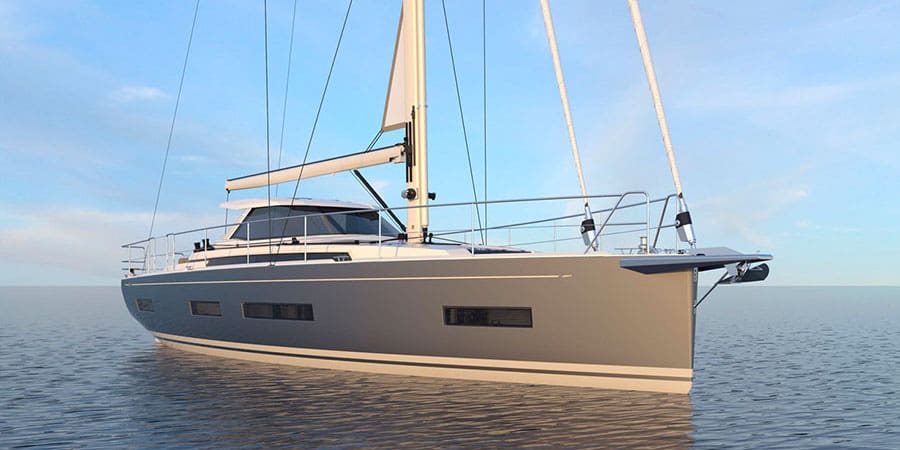
Unlike its competitors, Amel in this concept relies on a helm station positioned midships – protected under the cockpit roof and with a rotating pilot chair at the helm. All the other new yachts stick to the twin helm aft. As with the big boats, work and leisure time on board are also strictly separated on board Bénéteau, Hanse, Sun Odyssey and X-Yachts of this size.
New Designs in the 20-meter Class
The elegance of the modern 20-meter yacht is mostly defined by a clarity of lines above the waterline. No embellishments or flourishes, flat superstructures and clearly laid-out cockpits are features that are, for example, characteristic of both the Bavaria C65, the new flagship from Giebelstadt, as well as the French CNB66 or the Italian Solaris 68.
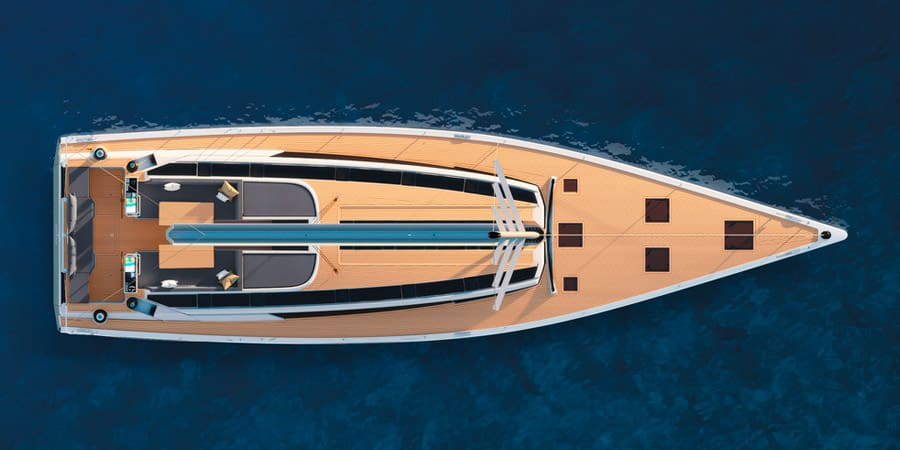
The flat decks on the bow of all three yachts have embedded windows, no stumbling blocks anymore when you move on deck. At the mast, cabin structures rise out of the deck in a smooth transition and barely noticeable up towards the cockpit. A long row of windows along the superstructures and additional skylights in the cabin roof allows plenty of light into the saloon.
The spacious cockpits offer relaxed seating on deck for guests in front of and separated from the working area. Lounge furniture turns the cockpit into a summer terrace, and lowerable tables, like on the Bavaria C65, create large sun loungers.
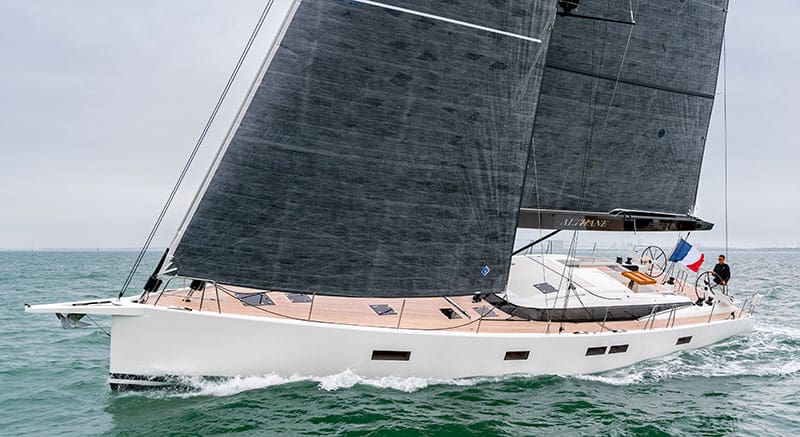
At the rear end of the cockpit, the helmsman is positioned to windward at one of the two steering wheels and has an excellent overview of the entire deck, which offers no visual barriers. Halyards, sheets and stretchers all come together next to the helm station and can be operated without leaving it by two powerful winches on both sides.
But there is also ample space for luxury and accessories on the big boats. A tender garage concealed behind the bathing platform, which allows storage of a well-sized tender, jet ski or other playthings, is standard on large sailing yachts. It not just allows to have more fun time on the water but also provides flexibility when anchoring in remote bays.
Wider sterns, flexible crew size & foils
The trend for rather wide sterns has various reasons, advantages and effects that come with it. The low, tapering aft design of these yachts is borrowed from the ocean racers, facilitating high performance levels particularly on downwind courses.
The planning potential is significantly increased. At the same time, the hydrostatical stability of the yachts is strengthened, which is further enhanced by the lowered freeboard at the sides.
Below decks, this design opens up new spaces, which are utilized by most modern designs for generous cabin layouts. Thus, yachts of all sizes are turned into real space wonders, well-equipped to cruise comfortably with family and friends.
This philosophy is supported by an ever-growing flexibility of shipyards in the interior design and layout of cabins. Different layout versions of yachts and even more interior design options offer owners the opportunity to model serial yachts according to their individual needs and preferences.
The twin rudders and helm already mentioned earlier may also be seen as an outcome of the broader sterns as two rudder blades help to keep the boats easily under control even when heeling in stronger breezes. Otherwise longer rudder blades would be required to reach the same manoeuvrability, as to be seen in the new Hanse Yachts and Najad models.
The large amount of space available below decks on these new boats is not limited to the stern section, though, but continues midships and in the bow. With a width-to-length ratio of 1:3 or 1:3.5, there is plenty of space for the lounge, pantry and navigation areas.
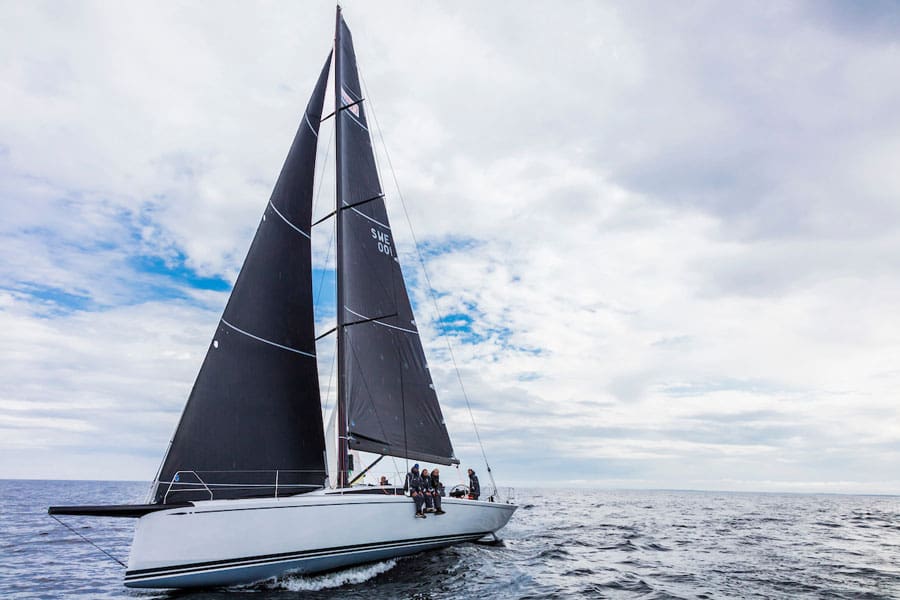
Natural light enters through numerous, large hull windows over the whole length of the cabin. The generous use of space can also be continued in the front cabins as the design features borrowed from racing yachts have positive effects for cruisers in this respect, too.
The straight, almost vertical bow has primarily functional reasons as it has proven to sail yachts through the waves rather than over them, thus keeping the yacht more stable on its course. By now, some argue, even our aesthetic sense has adapted to the functional design that has become so common. The straight lines at the bow also appeal to our eyes. And interior designers are grateful for these changes as they leave more space to utilize for long bunks and storage in the front cabin.
In addition to the symbiosis of performance sailing, cruising and bluewater qualities, these new yacht designs are also very adaptable to different crew sizes. The straight lines of the hull and deck are not disturbed by any sheets on deck. All sheets and halyards are concealed inside the deck, which makes it almost inevitable that all lines lead directly to the helm station.
Manoeuvres can thus be executed without leaving the helm or the cockpit. Self-tacking jibs and furling mainsails as well as jibs and genoas make large yachts suitable for short- or even one-handed sailing.
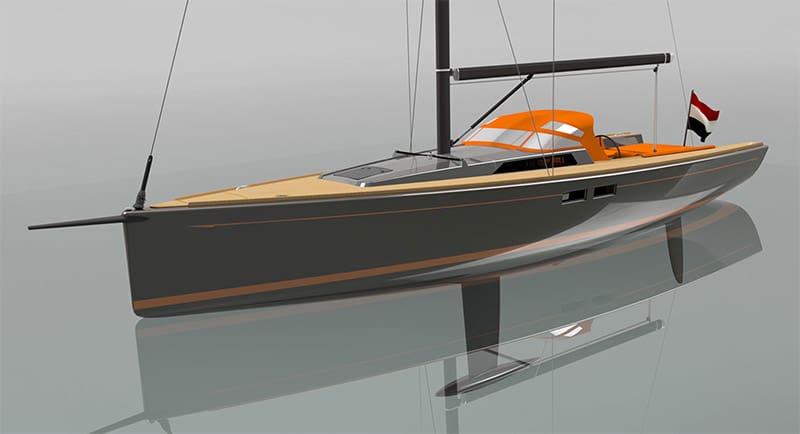
In terms of the sail plan the new yacht models also follow the lead of the racing yachts: gennaker and code zero are the standard choices in current yacht design. Mounted on a solid bowsprit or a powerful fitting on the bow, these large kites are easily hoisted and controlled.
A new yacht which takes the issues of performance and single-handed sailing on a serial yacht to extremes is the Figaro Bénéteau 3. The 11-meter performance yacht was designed for the single-handed „Solitaire le Figaro“ race. The intention is to have 50 of these racers ready for the 2019 edition of this race. And indeed, the Figaro 3 will take this race to a new level.
Because this monohull is a foiler with foils attached to the hull at the sides and bed downwards. Thus, the leeward foils and the deep keel produce a very strong righting moment – as well as uplift at the same time. The reduced displacement will take the yacht to new speed levels and make it a highly interesting option for regatta sailors.
The new models on display at BOOT Dusseldorf 2018 from January 20th to 28th show that they are suitable both for cruising and performance sailing.
Another eye-catcher at BOOT Dusseldorf 2018 will be the LA 35. Its smaller sister, the LA 28, already managed to get a lot of attention last year. Her rounded lines built in moulded wood delighted fans of classic boat-building. But the LA also proved convincing in terms of her sailing characteristics.
The LA 35 continues this story in terms of design as well as standards. Extended in length by 7 ft., the new model can offer more space and features four bunks and a pantry below decks. This makes her a bit more than just a daysailer, but the boat remains easy to handle and always read for a quick sail.
The same may be said about the Saffier SE37 Lounge. Easy handling, good sailing characteristics and a large lounge area in the cockpit aft of the two steering wheels are the hallmarks of this Dutch yacht. Four bunks below decks widen the scope of this racer for weekend cruising.
Nautor Swan even extends this concept into the luxury class of sailing yachts. With their ClubSwan 50 the Finnish yacht builders present a 17-meter yacht completely geared towards performance. Yacht designer Juan Kouyoumdjian transfers experiences and know-how gained from the Volvo Ocean Race and other maxi racers to the Swan, with its wide, chined hull and concave shape at the stern designed completely with a view to highest speed potential, stability of course and easy handling at the helm.
Discover more at BOOT Dusseldorf 2018.

